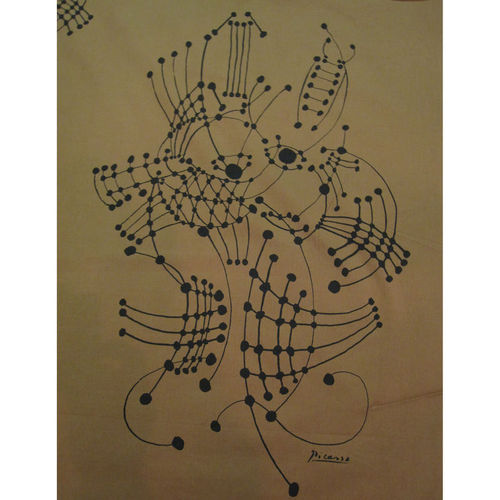
I’ve come across ads while surfing through New Yorkers from the 1950s, but this is one of the first times I’ve seen actual Pablo Picasso silk screened fabric turn up on eBay. And there’s a whole 16-yard run of it, too. $46/yd doesn’t seem like that much, either. Why, you could pay that much for the “fluoridized with DuPont Zepel ®” part alone.
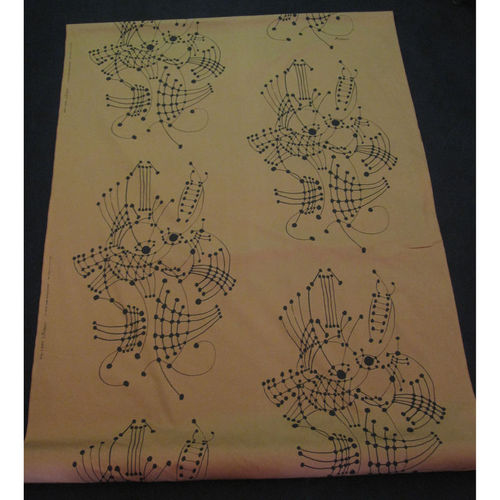
Vintage Bloomcraft Picasso Line & Dots Fabric 16yd+ Screen Print RARE! UNUSED! starting bid $749
Category: etc.
Artificial Snow
Oh man, JWZ’s digital TV plays analogue static when there’s no HDMI input:
Video static is caused by amplifying random radio white noise and feeding it to the input stage of a scanning electron gun. HDMI is digital and DRM’ed all the way through: there is no analog phase here at all!
This TV is playing a built-in MPEG of static, instead of just displaying solid blue or solid black like they used to do.
I think that’s kind of awesome. The map has become the territory.
Skeumorphantastic comments, too.
Snow Crash [Simulated] [jwz.org]
The VW Years: Carolyn Brown, Part I
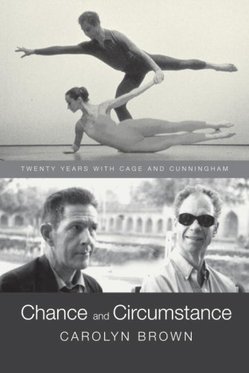 Well first off, apologies to Remy Charlip. I’d said he was “a bit off on dates” when he wrote about touring with Merce in a VW Microbus driven by John Cage from 1956-61. When we know [sic] that Cage only bought the bus in 1959, after winning a stack of dough on a rigged Italian game show.
Well first off, apologies to Remy Charlip. I’d said he was “a bit off on dates” when he wrote about touring with Merce in a VW Microbus driven by John Cage from 1956-61. When we know [sic] that Cage only bought the bus in 1959, after winning a stack of dough on a rigged Italian game show.
But now, who knows? Those dates match up perfectly with the memoir of Carolyn Brown, one of Merce’s first principal/partners, and, like Charlip, a member of the Company from the earliest Black Mountain College days.
In fact, the chapter of Chance and Circumstance which lent its title to this series of posts, “The VW Years,” begins in:
November 1956. John and Merce borrowed money to buy a Volkswagen Microbus, the vehicle that defined–willy-nilly–a classic era of the dance company’s history: the VW years. Our first VW-bus jaunt was crazily impractical, but according to a postcard sent to my parents, “a very happy trip.” To give two performances, we drove for two days and one-third of the way across the country and, although I don’t know how Merce was able to afford it, we stayed, for all the world like a professional dance company, in a big city hotel–the Roosevelt in downtown St. Louis. [p. 164]
What’s remarkable about these “VW Years” in the mid-50s was how little use the bus actually got. The centerpiece of the chapter is actually a groundbreaking Jan. 1957 performance at BAM that caused a downtown uproar–but which was followed by months-long stretches of absolutely nothing at all. The company performed so little in 1957 that Brown ended up joining the ballet corps at Radio City Music Hall, a grueling gig that left her exhausted and injured, but with money in the bank.
The detailed, finely, painfully felt atmosphere Brown conjures up is both eye-opening and engrossing; the rejection, ignoring crowds, poverty and hardship of this era of Merce & co’s career–indeed, of the whole downtown scene–seems hard to imagine from the comfortable, iconic present. And though I’m neither a big biography nor dance guy, I repeatedly found myself thrilled and literally laughing out loud at Brown’s stories.
The VW Years were also the Bob and Jap years, when Rauschenberg and Johns designed costumes and sets for the Company. In 1958, the two artists and Emile de Antonio produced a 20-year concert retrospective of John Cage’s work, followed in Feb. 1960 by a Manhattan performance for Merce’s company.
Merce worked out the program for what would turn out to be a “traumatic” New York performance on a tour through Illinois and Missouri:
After the eleven-day tour, six of them spent in the close quarters of our Volkswagen bus, everyone had or was getting a cold. In Viola [Farber]’s case the cold developed into bronchial pneumonia. By February 16 she was acutely ill. At the end of her umbrella solo in Antic Meet her legs were cramping so badly she barely made it into the wings. Merce, entering from the opposite side for his soft-shoe number, couldn’t help seeing her, on the floor in the wings, unable to walk, tears streaming down her face. Afterward he said that as he went through the motions of his solo his mind was racing: What happened? Will she be able to continue? What will we do if she can’t? At the intermission he picked her up in his arms and carried her upstairs to the women’s dressing room. The cramps finally subsided and she assured him she could continue. Cod knows how she got through Rune, but she did. [p. 260]
Brown is sympathetic but unflinching in her account of the difficulties of working with Cunningham, and of the toll the company’s lack of performances and new choreography took on Merce the dancer, who, in Brown’s telling, grew grim and depressed as he watched his peak physical years passing him by. By 1961, things were not quite so grim, with ten performances booked in nine states between February and April; which may make this the Golden VW Year:
I think Merce was even more relived than I to be touring with the full company, and his self-confidence seemed fully restored knowing that the company had been engaged on the basis of his reputation as dancer and choreographer rather than by avant-garde musical festivals based on John’s and David [Tudor]’s reputations. John and David were with us, of course, to play piano for Suite and Antic Meet. John, on leave from Wesleyan, also resumed his duties as chief chauffeur, cheerleader, guru, and gamesman. Once again, nine people tucked themselves into the Volkswagen Microbus, sometimes spending as many as eighteen out of twenty-four hours together. Singing, snoozing, reading, knitting, arguing, laughing, telling stories, playing games, munching, and sipping, we whiled away the hours and miles between New York City and De Kalb, Illinois, De Kalb and Lynchburg, Virginia…etc. We totaled six days and one full night on the road plus six hours in the air just to give four performances. Ridiculously long journeys. One performance we gave having had no sleep at all, dancing in Lynchburg, Virginia, on Tuesday night, then, after a party, driving all night to Richmond, Virginia, to catch a plane to Atlanta and another to Macon, where we performed Wednesday night after rehearsing in the afternoon. It was impractical. Exhausting. Wonderful. [pp. 313-4]
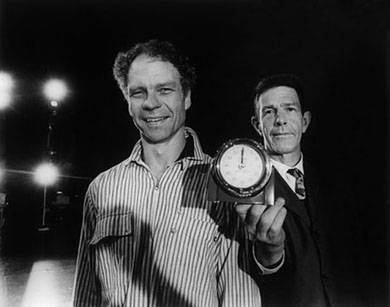
There’s one more excerpt which I’ll go ahead and quote from at length, where Brown really brings home the reason why I’ve become kind of fascinated with Cage’s VW bus in the first place. At 11PM, as the year ends, and Merce Cunningham Dance Company is performing for the last time at the Park Avenue Armory–and as I gave my tickets to these final Legacy Tour events to a good friend when I realized our travel schedule meant we couldn’t attend ourselves–and as Cage’s centennial year begins, I am looking forward to soaking in Brown’s insightful account of the scrappy, crazy, foundational era of the company and the artists in its orbit.

“The Final Bows: Merce Cunningham Dance Company, December 31, 2011” [@parkavearmory]
Richard Serra: The Suburban Years
The very special presentation of Merce & John: The VW Years will return after this brief announcement from holy crap, Richard Serra’s suburban!
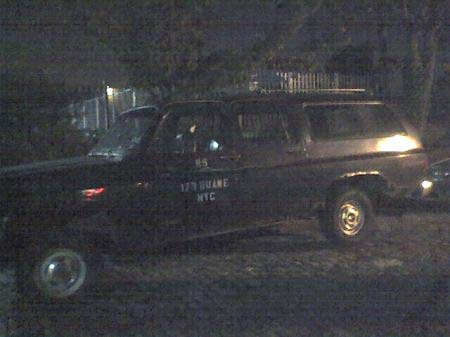
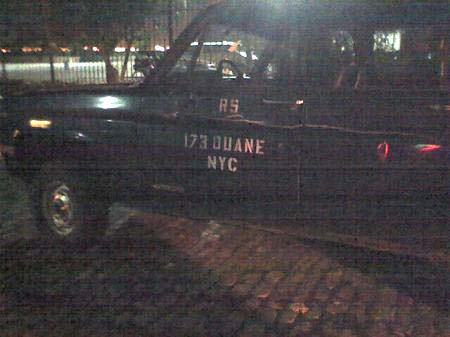
Thanks, wary meyers! Now don’t get all stalky. And stay tuned, eventually, finally, for Donald Judd’s Land Rover.
No One Puts Big Nose Baby Moose In A Corner
Sometimes all Mark Grotjahn wants is to dance. Here are four five videos of those times, in chronological order:
Nov. 2007:
Jan. 2008:
May 2008:
Feb. 2011 [via artblogartblog]
May 2012:
Alexander Girard Shelves? Alcoa Forecast Throwback
You know what I never got around to doing in 2010? Finishing the catalogue of all the designs created for the Alcoa Forecast ad campaign in the late 1950s.
That was the postwar, civilian/consumer-oriented, Glorious Aluminum Future PR campaign that gave birth to the Eames Solar Do-Nothing Toy. Which is by far its greatest claim to fame.
But still, there were other products, prototypes, designs, toys, sculptures, concepts. Like the ones I ran across in April 2010: Eliot Noyes’s design for a carport-like, aluminum & Perspex shelter; satelloon-esque, spherical prototypes for a portable oven by Greta Magnusson Grossman and the Music Sphere, a hi-fi by Lester Beall; and modular prismatic side tables by Isamu Noguchi. Then I found a couple of boring ones, and got distracted.
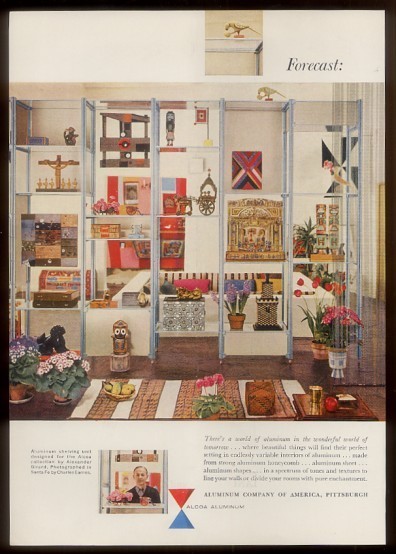
But I just stumbled across this tearsheet on eBay, which is probably from the July 27, 1957 issue of the New Yorker, and which shows a shelving system Alexander Girard designed for the Alcoa Forecast campaign. The photo, shot in Santa Fe, at Girard’s house, was taken by Charles Eames. Which, according to the timeline of John Neuhart, the Eames employee who actually created it, is about when the Solar Do-Nothing Machine was realized.

So Girard. Hmm. Overall, of course, awesome. But the shelves themselves? I gotta say, I’m not feeling it. The various panels in milk or smoked glass are fine, but the tubular metal seems off, and the feet are a mess.
The image itself seems to be more successful, or interesting, the way it collapses background and foreground into the shelves, which is funny, since they’re ostensibly meant to divide the space they inhabit, not flatten it. That Four Seasons-looking chain curtain thing on the right is especially odd/cool. And that Mary Heilmann painting top-center is freaking awesome.
The VW Years: Ch. 2, Remy Charlip & Steve Paxton
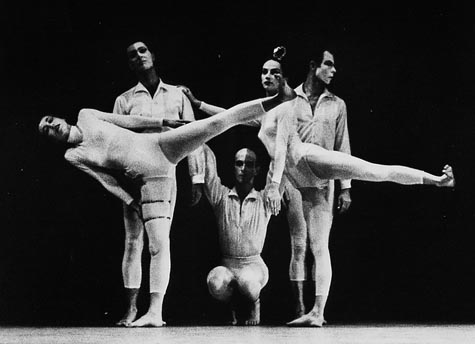
[l to r] Viola Farber, Bruce King, Remy Charlip, Carolyn Brown & Merce Cunningham performing Nocturnes in 1956. photo CDF/Louis A. Stevenson, Jr. via the estate project
Remy Charlip was an early collaborator in Merce Cunningham’s orbit. Years before he began his second or third acclaimed career as a children’s book illustrator and author, Charlip danced with Cunningham and Martha Graham in New York and at Black Mountain College. He created the programs for the August 1952 Cage et al performance at BMC which is considered the first “Happening.” They were printed on cigarette paper, and were placed at the entrance next to a bowl of tobacco, with an ashtray on each seat.
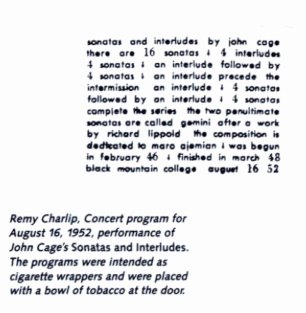
image of what has to be a Charlip program for a different Cage performance, via The Arts at Black Mountain College
Though he’s a bit off on the dates, what with Cage only buying the VW bus in 1959, John Held’s Charlip biography lays out the basic configuration of the bus:
As if BMC was not enough, Charlip received continuing post-graduate work from 1956-1961 in the back of a Volkswagen Microbus driven by John Cage, navigated by Merce Cunningham, enlivened by Robert Rauschenberg, with traveling companions Nicholas Cernovich and dancers Carolyn Brown, Viola Farber, Steve Paxton and others.
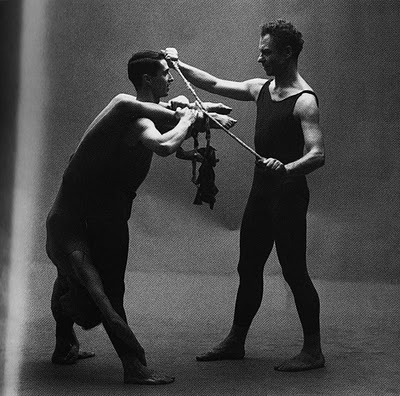
[l to r] Carolyn Brown, Steve Paxton & Merce Cunningham, 1961, image via cepress
A couple of weeks ago, Paxton talked to the Washington Post about the bus: Later that year [1960? ’61? -ed.] Remy resigned, and I was invited into the smaller company. This meant touring around the U.S. in a Volkswagen bus, which, I was informed, it was my duty to pack. And unpack. And distribute and later collect all the items packed. There were the spaces under the seats, a compartment in the back, and a roof rack to transport nine persons’ personal luggage, the equipment of John Cage and David Tudor for various musical adventures, and the sets and costumes for the tour. The bus was heavy laden, and it never let us down, including at least two tours the the West Coast.
John or Merce drove, and John liked to play Scrabble when off-duty. The rest of us conversed and Viola [Farber] knitted. It was rather like a family around the hearth. Long silence, naps, breaks to stretch and walk about, and usually some amazing treat produced by John, a huge salad perhaps, or once Rogue River pears at perfect ripeness with pear liquor to accompany. David was quiet, Marilyn Wood chatty, Carolyn [Brown] and Viola made comment, Merce sometimes spoke, John and Bob laughed a lot, and both were great story-tellers. I remember the actual driving fondly.
It may have been amidst family-like intimacy of the bus that Paxton and Rauschenberg started the relationship that ended the relationship between Rauschenberg and Johns in 1961-2.

Robert Rauschenberg & Steve Paxton, with Alex Hay [l] and Trisha Brown [r] rehearsing Spring Training, 1965. image via SAAM Rauschenberg catalogue, 1976
The VW Years: Ch. 1
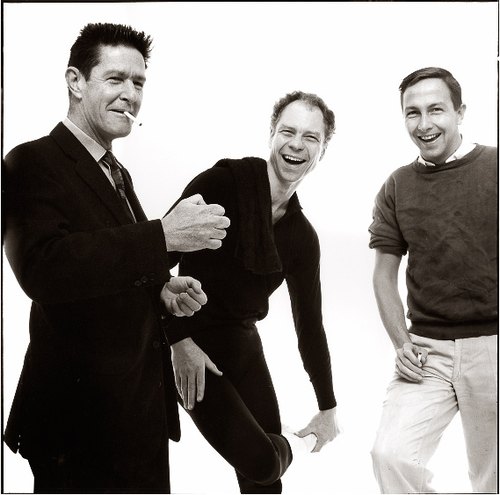
John Cage, Merce Cunningham, and Robert Rauschenberg photographed in 1960 by Richard Avedon
In a few days, the Merce Cunningham Dance Company will perform for the last time. I have not been a close follower of Cunningham’s work, except in the New Yorker way, how, for the two decades since I moved to the city, Merce and his company were an integral part of the cultural fabric. Merce? You’re soaking in it!
I was always more of a Cage fan. And so it’s been fascinating, and enlightening, and continually surprising over the last year or so, as I’ve been digging into the early days of Rauschenberg and Johns, trying to understand their formative work and context, to see how closely connected they were with Merce and John. How small the circle of artists was which generated so many incredible works and ideas. And yet how infrequently I consider their work in relation to each other, or consider the nature of their collaboration beyond the basic namecheck.
In a way, I guess Rauschenberg and Johns and their intense, but short-lived collaborative period serves as the antithesis of Cunningham and Cage’s lifelong partnership. But they all began so close, and so much together.
Anyway, as I’ve become more familiar and more admiring of Cunningham’s work and Cage’s work with him, I’ve begun trying to piece together the world they inhabited in the late 1950s and early 1960s, when they were just starting out. And one thing that comes up in every story about those days is the VW microbus Merce and his fledgling company would pile into to tour the country. Cunningham’s longtime principal dancer Carolyn Brown even titled the chapter in her 2007 memoir “The VW Years.”
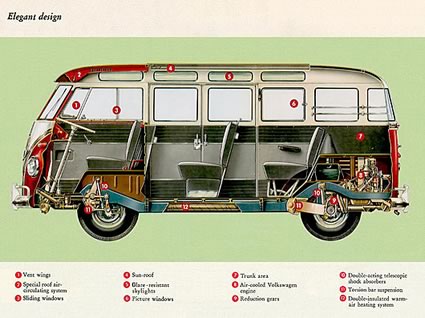
But I’ll get to that. First, the story of the VW bus itself, how John Cage bought it, and how it figured into various peoples’ accounts of those crazy, early days.
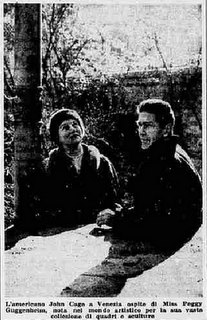 In 1958, Cage had performed at a blowout retrospective concert organized by Johns, Rauschenberg, and hustler/activist/filmmaker Emile de Antonio; and he’d exhibited his scores at Stable Gallery. Then in the taught and performed in Europe, including at Expo ’58 in Brussels, and then settled into a several months’ residency in Milan at RAI, Italian state television. In February of 1959, after hanging out with Peggy Guggenheim at her Venetian palazzo, he appeared on Lascia o Raddoppia, the local equivalent of the $64,000 Question, where he performed new compositions, became famous by the end of the week–and ended up winning 5 million lira in a series of ridiculously rigged questions about mushrooms.
In 1958, Cage had performed at a blowout retrospective concert organized by Johns, Rauschenberg, and hustler/activist/filmmaker Emile de Antonio; and he’d exhibited his scores at Stable Gallery. Then in the taught and performed in Europe, including at Expo ’58 in Brussels, and then settled into a several months’ residency in Milan at RAI, Italian state television. In February of 1959, after hanging out with Peggy Guggenheim at her Venetian palazzo, he appeared on Lascia o Raddoppia, the local equivalent of the $64,000 Question, where he performed new compositions, became famous by the end of the week–and ended up winning 5 million lira in a series of ridiculously rigged questions about mushrooms.
And so he took his winnings and Italian fame back to the US, where he used part of the money to buy a piano for himself, and a white VW microbus for Merce and the company to tour in.
The most extensive accounts of the Italian game show boondoggle and the VW van purchase are from Begin Again, Kenneth Silverman’s Cage biography, and Stefano Pocci’s guest post on the John Cage Trust blog.
Lascia o Raddoppia, Milan, 1959 [johncagetrust]
Beautiful Boro Noragi @ Sri

I love this boro jacket at Sri as much for the color as the patching:
This jacket is well-used, as is quite obvious. To describe its color is difficult: it is a kind of medium-range grey blue; the hemp cloth itself is woven of exceedingly narrow stripes which gives a misty appearance to the neutral color.
This is actually the inside of the jacket. The 10 other photos Sri posted doesn’t include a shot of the outside.
boro hemp noragi, taisho era [srithreads]
On The BELLMAC-32, And Perhaps The World’s Largest Plotter Pen Drawing
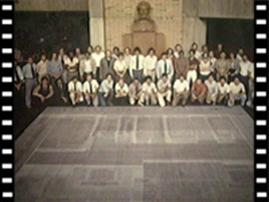
BELLMAC-32A Layout in the Ball Labs, Murray Hill Lobby, image: ieeeghn.org
Look closely, at least until I can track down a larger version of this snapshot.
Because it may be the world’s largest plotter pen drawing.
It’s a 20×20-foot layout of the BELLMAC-32, the world’s first 32-bit microprocessor, developed by AT&T just before they divested themselves of Bell Labs and the RBOCs beginning in the late 1970s.
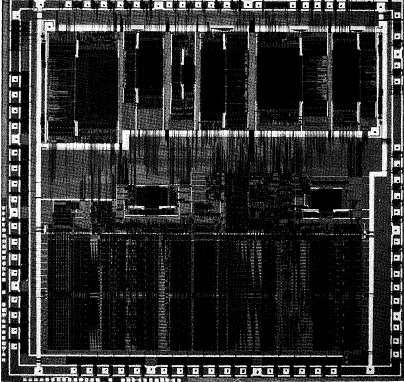
BELLMAC-32A microphotograph, via ieeeghn.org
According to a first-hand history of IEEE fellow Dr. Sung Mo (Steve) Kang, developing the BELLMAC-32 constantly uncovered the limitations of the design, testing, manufacture, and QA process for microprocessors:
Chip layout verification was another huge challenge. At that time, no CAD tools were available for the entire chip layout verification. As a result, we had to generate many CALCOMP plots and Scotch-taped them together to form a 20-foot-by-20 foot plot that was placed on the floor in a huge room. To make sure interconnects were formed properly, all terminals were labeled and wires were traced by using color pencils to make sure the lines ran continually. Although primitive, this method uncovered many errors and, in the end, produced error-free layouts and fabricated chips. We used a huge empty room in Building 3 of AT&T Bell Labs at Murray Hill or the main lobby area to complete the checking.
I love that creating the most advanced computer chip of the day still involved PhDs crawling across the floor with colored pencils.
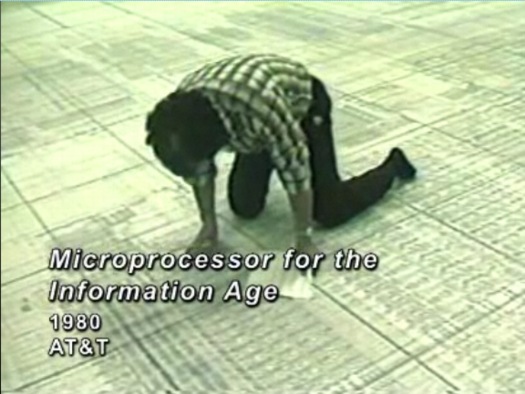
Still from Microprocessor for the Information Age, a 1982 industrial film on the making of the BELLMAC-32, via AT&T’s Archive
And of course, there’s the giant drawing itself, spit out by a printer in tiles and taped together. Was Wade Guyton even born when this all went down? Yes, but still. So awesome.
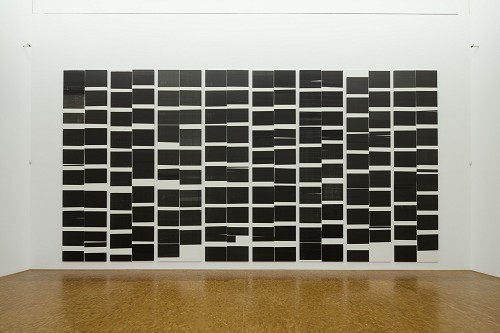
Now to track down a working CALCOMP plotter and recreate it. Because it’s probably too much to hope that AT&T or one of their computer engineer diaspora rolled all those sheets up and stuck them in their moisture-free basement. Right?
Microprocessor for the Information Age (1982) [techchannel.att.com thanks greg.org reader robin edgerton]
First-Hand: The AT&T BELLMAC-32 Microprocessor Development [ieeeghn.org]
previously: Shatner, plotter art, and the drawing machine as seen at the beginning of the digital age
The New Aesthetic On Stage
Here’s video of James Bridle giving a live, keynote speech version of his awesome tumblr, The New Aesthetic, at a web conference in Australia. Lots of good stuff, though not much that will be new to TNA followers.
There are a few greg.org favorites in there, too, including lots of camo, Dutch Google camo, Blurmany, that crazy Google Books book, Google Google Google camo camo camo.
Waving At Machines, at Web Directions South, Sydney AU [booktwo.org]
John Cage’s Sweet Nut Balls
Here’s another recipe from John Cage, this one maybe from a stay in Ithaca? Before he went vegan, obviously. From Empty words: writings ’73-’78, p. 91:
Holiday Inn: Room 135.
Four cups of ground walnuts;
4 cups of flour;
12 tablespoons of sugar;
2 2/3 cups of butter;
4 teaspoons of vanilla.
Form into circa 125 small balls.
Bake at 350 degrees in motel oven.
Now back to Room 135.
Roll in 1 pound of powdered sugar.
Nut balls.
Makes enough for one dance company, I guess.
And Now Erased Kennedy?
Wild. The previous post about erased and archived and someday-to-be-resuscitated Nixon reminded longtime greg.org reader Jonathan of another obscured national conspiracy: the Dictabelt recordings of the Kennedy assassination.
Apparently, a motorcycle policeman along the presidential motorcade route through Dallas had his mic stuck open, and he inadvertently laid down several minutes of audio on a police radio channel, which was being recorded by something called a Dictabelt.
Generations of investigators who examined the recording drew controversial and sometimes conflicting conclusions from it about the participation of a second gunman. But basic questions about which policeman’s radio was being recorded, and where he was at the time, have never been answered definitively.
In any case, the celluloid acetate medium on which the recording was made is microscopically degraded further with every pass of the stylus. So the more it is disputed and heard and analyzed, the more it is physically erased.
Dictabelt evidence relating to the assassination of John F. Kennedy [wikipedia, thanks jf]
Coke Slab By Sebastian Errazuriz
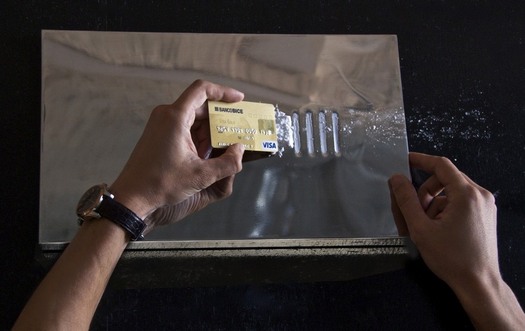
Sebastian Errazuriz came up with the idea for his coke slab when he saw friends scratching out lines on a coffee table. The indentations make it so easy, a child could do it!
It’s so functional and brilliant, I’m surprised someone hasn’t invented it already. It’s also gorgeous to look at, though it also appears that the actual production version available for sale on Grey Area’s website is matte finish, not mirror-finish stainless steel. Too bad.
Maybe better to wait for Rirkrit‘s version.
[Other things I just thoguht of: Painting Bitten By A Man, 1961, Jasper Johns; Table, also 1961, Yves Klein.]
COKE SLAB
Sebastian Errazuriz, 16 x 9 x 0.75 inches, $2,100 [shopgreyarea.com via museumnerd]
Where Is Enzo Mari’s ‘Where Is The Craftsman?’
In what is probably the most ideologically analytical essay ever written about paperweights, curator Barbara Casavecchia notes that many of the 60 paperweights she selected from Enzo Mari’s collection “are the product of a manual labor–serving as fragmented evidence of the persistence of non-alienating forms of work, specifically within the craftsman-like dimension inherent to production that Mari has investigated for years.”
One incarnation of Mari’s investigation was an exhibition and discussion forum he organized in 1981 titled, “Dov’e l’artigiano”/”Where is the crafstman”. It was presented first at Fortezza da Basso in Florence, and then at the Triennale in Milan. There was a catalogue published–which I can’t find anywhere–and at least one review–which I can only find a few quotes from, but otherwise, the Italians have not yet processed or digitized their contemporary design history yet.
In his latest book, Venticinque modi per piantare un chiodo/25 ways to drive a nail, Mari says the objective was to “illustrate the unresolved ambiguity of the relationship between industrial design and ‘handmade.'”
Excerpts from an Ottagono review of “Dov’e l’artigiano” place the show and Mari’s critical view of the alienating labor conditions of mass production at the center of the debate over Italian design, culture, business, even a national identity of sorts. On the one hand, some Italian producers, still modernizing, hid the fact that their consumer products were partially made by hand because they “did not want to lose the noble title” of industrial design. And others hid the fact that they’d begun using industrial manufacturing processes because they didn’t want “to lose the prestigious title of an object ‘made by hand.'”
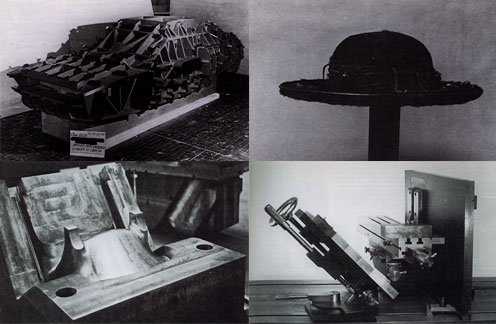
As he had done in 1973 with his autoprogettazione plans, exhibition, and product line, Mari eschewed theoretical arguments in favor of a “didactic exhibition” of objects and the close analysis of their creation. For the show he uncovered hundreds of examples of artisanal and craftsman-like processes being used to make mass-produced industrial design. Here are the objects and categories I’ve been able to find so far:
- Industrial prototypes and models made by craftsmen, such as hand-formed auto body parts by Italdesign’s Giorgetto Giugiaro and Aldo Mantovani for Alfa Romeo [top left, I think]
- Scale models and testing prototypes of turbines.
- A hand-made mold for high-quality plastic chairs [bottom left].
- The schematic drawing for an integrated circuit, which apparently took over 1800 man-hours to create. [I believe it]
- “Technological masterpieces” such as US nuclear submarines, one-off industrial objects.
- An 18th-century-style table with legs “built in series with industrial machinery, but finished with a stroke of the chisel to make it ‘unique.'”
- A Borsalino custom-made for the Pope [top right].
- A machine-like sculpture by Mari collaborator Paolo Gallerani [bottom right].
Oh yeah, and the whole show took place inside a geodesic dome.
I’ll add more objects and pictures if/as I find them. It’s hard to process a 30-year-old exhibit you’ve only just found out about. But it makes me think of things like, well, obviously, pen plotters and that insane William Shatner integrated circuit drawing movie. And NASA workers using giant clothespins to glue the mylar strips toghether for Project Echo satelloons. And Richard Serra sculptures made in defunct shipyards and Richard Prince car hoods. And hand-embroidered Gap kids’ dresses that turn out to have been made by children in India. And etsy and custom Nikes and pre-stressed jeans. And Ikea furniture that offloads all the non-alienating labor processes onto the customer.
Which is all by way of saying I have no grand theories on the current state of the relationship between craft and industrial production; but I think they’ve turned out to be not quite as incompatible as they seemed in 1981.
LINKS/RELATED
This all started with the catalogue essay for Enzo Mari: Sixty Paperweights, An Intellectual Work, which just closed in Berlin. [kaleidoscope-press.com, tanyaleighton.com]
Maddamura’s discovery of the Ottagono review is one of the few online sources of info on the “Dove’e l’Artigiano” show [image, too: maddamura.eu]
Mari’s new book, 25 Ways to Drive A Nail, is not available in English yet. [google books tho]
